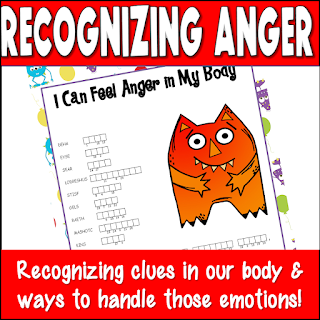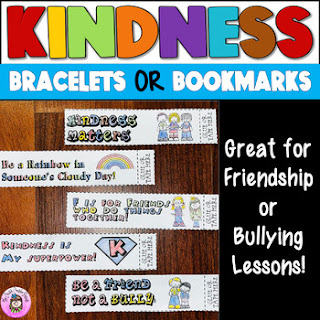Hey there! Today I wanted to share about one of my favorite small group Anger Management activities. Our bodies give us clues that we are getting angry and if we can tap into those clues ahead of time, we can be proactive in handling those emotions.
We start with a fun word puzzle activity called "I Can Feel Anger in my Body Word Puzzle" and then make Anger Journal Books. These activities help students identify their own body’s reactions and understand their response to anger.
Let’s look into the benefits of these activities and how they can help kids manage their anger better.
Recognizing Body Clues:
So, the first thing we did was this awesome word puzzle. We unscrambled words to figure out different body parts and how they react when someone is getting angry. The kids came up with all sorts of cool stuff! They said their heart beats fast, they feel butterflies in their stomach, their hair stands up, their fists get all tight, their face gets hot, their ears stop working, and their breathing gets heavy. It was amazing to see them share their experiences, and I drew it all on the Smart Board to make it more fun!
Benefits of Recognizing Body Clues:
Recognizing the clues from our bodies when we're angry has some pretty neat benefits for kids. First off, it helps them become more self-aware. By knowing what their bodies are telling them, they can understand their emotions better. It also helps them stop anger from getting out of control. When they recognize those signs early on, they can take a step back and use some calming strategies to deal with their anger in a healthier way.
Creating Anger Journal Books:
Now that we know what clues our bodies give us and the way we react, we make these awesome Anger Journal Books using paper bags. We cut the edges of three paper bags and fold them in half to make pockets. It was super simple! On the front cover, we glued on the statements we talked about in our group.
Inside the journal, the kids got to decorate the pages with drawings of the body parts that give them clues when they're getting angry. We put a small picture of a body part in each pocket, and on the back, they completed a statement about when they felt angry. They wrote things like, "Today I felt angry. I knew I was angry because my body gave me clues. I could feel ______________. I handled my angry feelings this way ___________." It was like having their own secret diary!
Benefits of Anger Journal Books:
These Anger Journals are really something special. They give the kids a way to track their anger and how they handle it over time. By writing and drawing about their anger, they can understand it better and learn from their experiences. It's like having a little window into their emotions. Plus, it helps them become more self-aware and emotionally intelligent, which is super important!
Here are some additional activities that could be done...
Mindful Breathing: Teach students a simple breathing exercise to help them calm down when they feel angry. Encourage them to take slow, deep breaths, counting to four as they inhale and exhale. They can practice this technique whenever they start feeling the physical clues of anger.
Role-playing Scenarios: Create hypothetical situations that might trigger anger in students and have them act out different ways of responding. This activity allows them to practice using their anger management strategies in a safe and controlled environment.
Emotion Charades: Write down various emotions, including anger, on small pieces of paper. Have students take turns picking a paper and acting out the emotion without using any words. The rest of the group can guess which emotion is being portrayed. This activity helps students recognize and understand different emotions, including anger, both in themselves and others.
Emotion Collage: Provide magazines, scissors, glue sticks, and large sheets of paper. Ask students to cut out images or words that represent different emotions, including anger. Then, they can create collages by arranging and gluing these images onto the paper. This activity helps students explore and express their emotions visually.
Worry Dolls: Have students make their own worry dolls using pipe cleaners, yarn, and small fabric scraps. As they create these dolls, explain that they can share their worries and angry feelings with the dolls before going to sleep. This craft encourages students to externalize their emotions and feel a sense of relief.
Calming Sensory Bottles: Provide empty plastic bottles, water, glitter, and small objects like beads or sequins. Students can fill the bottles with water, add glitter and small objects, and seal them tightly. These sensory bottles can serve as calming tools, as students watch the objects swirl and settle, helping them relax and refocus their thoughts when feeling angry.
Anger Thermometer: Create a large thermometer template on a poster board or chart paper. Have students decorate and label it with different anger levels, such as "cool," "warm," "hot," and "exploding." Encourage them to draw or write about specific strategies or activities they can use to bring their anger levels down. This visual representation helps students monitor and regulate their anger intensity.
Feelings Masks: Provide paper plates, craft supplies like markers, paints, and yarn, and elastic bands. Students can decorate the masks to represent different emotions, including anger. They can then use these masks in role-playing activities to express and manage their emotions effectively.
Teaching elementary students about anger management is such a valuable skill! By recognizing the clues their bodies give them and creating Anger Journal Books, kids can learn to handle their anger in a healthier way. It's all about understanding themselves better and finding effective strategies to manage their emotions. These activities are a great step toward helping them become more self-aware, regulate their emotions, and handle challenging situations like pros!
Ready to Use Resource
Shop here for this resource:
Looking for more lessons about handling emotions? Check these out!













